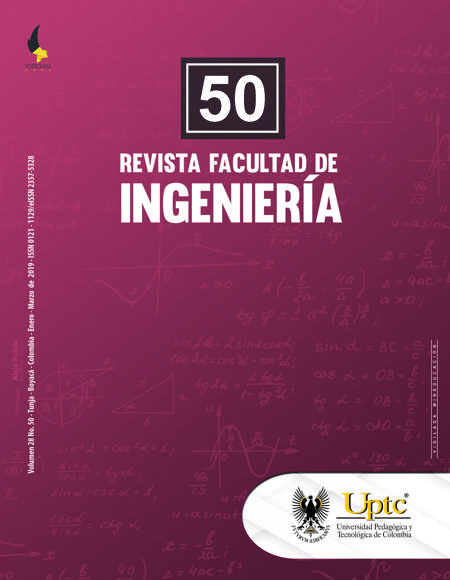Finite elements analysis of the deformation applied to the 6061-T6 aluminum alloy by equal channel angular pressing

Abstract
The severe plastic deformation process Equal Channel Angular Pressing (ECAP/ECAE), was simulated under the theory of finite elements using the software ANSYS, in search of different elastoplastic responses that can be presented to a sample of 6061-T6 aluminum alloy. Variations of the mechanical parameters of the ECAP matrix, such as its geometry (external angle (Ψ) and internal angle (Φ)) and the friction conditions of the process were studied. The influence of each of these parameters on the behavior of the material was analyzed. The results obtained were compared with the theoretical predictions that have been arranged throughout the ECAE / ECAP study by different researchers.
Keywords
aluminum alloy, ECAE, engineering software, SPD, strain
References
[1] H. Gleiter, “Nanocrystalline materials,” Progress Materials Science, vol. 33, pp. 223-315,1989.
[2] Y. T. Zhu, T. C. Lowe, and T. G. Langdon, “Performance and applications of nanostructured materials produced by severe plastic deformation,” Scripta Materialia, vol. 51 (8), pp. 825-830, Oct. 2004. DOI: https://doi.org/10.1016/j.scriptamat.2004.05.006.
[3] R. Z. Valiev, and T. G. Langdon, “Principles of equal-channel angular pressing as a processing tool for grain refinement,” Progress in Materials Science, vol. 51 (7), pp.881-981, Sep. 2006. DOI: https://doi.org/10.1016/j.pmatsci.2006.02.003.
[4] V. M. Segal, “Materials processing by simple shear,” Materials Science and Engineering A, vol. A197, pp.157-164, Jul. 1995. DOI: https://doi.org/10.1016/0921-5093(95)09705-8.
[5] R. Z. Valiev, N. A. Krasilnikov, and N. K. Tsenev, “Plastic deformation of alloys with submicron-grained structure,” Materials Science and Engineering A, vol. 137, pp. 35-40. May. 1991. DOI: https://doi.org/10.1016/0921-5093(91)90316-F.
[6] R. Z. Valiev, “Structure and mechanical properties of ultrafine-grained metals,” Materials Science and Engineering A, vol. 234-236, pp.59-66, Aug. 1997. DOI: https://doi.org/10.1016/S0921-5093(97)00183-4.
[7] Y. Saito, N. Tsuji, H. Utsunomiya, T. Sakai, and R. G. Hong, “Ultra-fine grained bulk aluminum produced by Accumulative Roll-Bonding (ARB) process,” Scripta Materialia, vol. 39 (9), pp.1221-1227, Oct. 1998. DOI: https://doi.org/10.1016/S1359-6462(98)00302-9.
[8] Y. Saito, H. Utsunomiya, N. Tsuji, and T. Sakai, “Novel ultra-high straining process for bulk materials-development of the Accumulative Roll-Bonding (ARB) process,” Acta Materialia, vol. 47 (2), pp. 579-583, Jan. 1999. DOI: https://doi.org/10.1016/S1359-6454(98)00365-6.
[9] V. M. Segal, V. I. Reznikov, A. E. Drobyshevski, and V. I. Kopylov, “Plastic working of metals by simple shear,” Russian Metallurgy, vol. 1, pp.99-105, 1981.
[10] Y. Iwahashi, J. Wang, Z. Horita, M. Nemoto, and T. G. Langdon, “Principle of equal-channel angular pressing for the processing of ultra-fine grained materials,” Scripta Materialia, vol. 35 (2), pp.143-146, Jul. 1996. DOI: https://doi.org/10.1016/1359-6462(96)00107-8.
[11] ASM Handbook, Properties and selection: Nonferrous alloys and special-purpose materials. Edition Metals Handbook. ASM International Handbook Committee, 1990.
[12] J. R. Bowen, A. Gholinia, S. M. Roberts, and P. B. Prangnell, “Analysis of the billet deformation behaviour in equal channel angular extrusion,” Materials Science and Engineering A, vol. 287 (1), pp. 87–99, Jul. 2000. DOI: https://doi.org/10.1016/S0921-5093(00)00834-0.
[13] A. Krishnaiah, K. Kumaran, and U. Chakkingal, “Finite element analysis of multi-pass equal channel angular extrusion/pressing process,” Materials Science Forum, vol. 654-656, pp.1574-1577, Jun. 2010. DOI: https://doi.org/10.4028/www.scientific.net/MSF.654-656.1574.